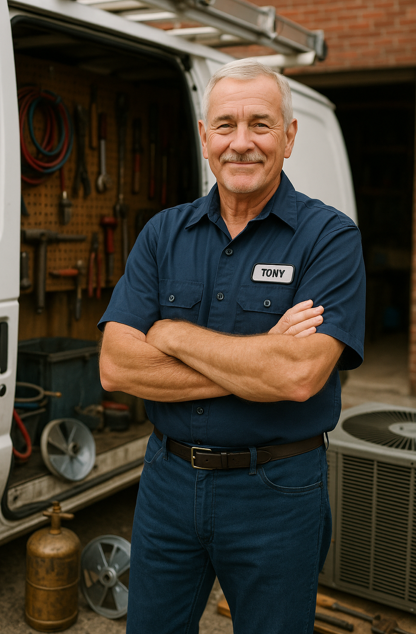Hey folks, Tony Marino here. If you manage a business, facility, or industrial workspace, you know just how critical commercial outdoor air conditioners and industrial portable air conditioners can be. Proper cooling isn’t just about comfort—it’s about productivity, safety, and protecting equipment.
In this guide, I’ll break down everything you need to know: differences between commercial and industrial units, key features, sizing tips, installation best practices, energy efficiency considerations, and top recommendations for 2025. And while this is focused on portable and commercial units, if you’re also thinking about whole-space cooling, the Goodman 3 Ton 14.5 SEER2 R-32 Split System remains a reliable, high-efficiency choice.
Understanding Commercial Outdoor Air Conditioners
What Makes a Unit “Commercial Outdoor”?
A commercial outdoor air conditioner is engineered to handle demanding environments while delivering consistent cooling for large areas. Unlike residential units, these systems are built to withstand harsh weather, dust, and heavy usage.
Typical applications include:
-
Outdoor event spaces and temporary structures
-
Construction and industrial sites
-
Warehouses and manufacturing facilities
-
Agricultural or livestock operations
These units must provide reliable performance under conditions where standard residential AC units would fail. They often feature reinforced housings, high-capacity compressors, and advanced weatherproofing.
For an overview of industrial cooling solutions, check out MovinCool’s guide to portable industrial air conditioners.
Key Features to Look For
When selecting a commercial outdoor unit, prioritize:
-
Durability: Weather-resistant components and rugged design
-
Cooling Capacity: Adequate BTUs to meet the area’s requirements
-
Energy Efficiency: High SEER or EER ratings to minimize operating costs
-
Portability: Some units include wheels or lifting handles for easier relocation
Commercial-grade outdoor units are designed for both reliability and efficiency, helping businesses maintain productivity even in extreme temperatures.
For more on choosing the right commercial AC, HVAC Direct offers a detailed buying guide.
Industrial Portable Air Conditioners
What Is an Industrial Portable AC?
An industrial portable air conditioner provides targeted cooling for demanding indoor or semi-outdoor environments. These units are ideal for:
-
Server rooms and data centers
-
Manufacturing plants and assembly lines
-
Temporary workspaces or event tents
-
Emergency cooling situations
Portability is key—industrial portable ACs often include caster wheels and handles, allowing staff to move them wherever cooling is needed most.
Features That Matter
When evaluating portable industrial units, consider:
-
BTU Rating: Higher ratings handle larger spaces and heavy heat loads
-
Noise Levels: Some units include sound-dampening features
-
Power Requirements: Check for standard outlet compatibility or specialized connections
-
Mobility and Design: Ease of relocation and durable construction
For a thorough review of top industrial portable air conditioners, check out Grainger’s portable air conditioner guide.
Top Commercial and Industrial Units for 2025
1. MovinCool Climate Pro K63
This 60,000 BTU industrial unit is perfect for warehouses, factories, and data centers. It combines portability with high performance and robust construction.
2. OceanAire OPAC Series
The OPAC Series offers industrial and commercial portable ACs with BTU ratings up to 144,000. They’re suitable for both indoor and outdoor use, providing reliable cooling in large spaces.
3. Portacool Jetstream 250
An outdoor evaporative cooler, the Jetstream 250 is designed for high airflow and large areas, such as construction zones, event spaces, or industrial yards.
For more on portable commercial cooling, see Portacool’s product information and applications.
Installation and Maintenance Best Practices
Proper setup and maintenance are essential for longevity and efficiency.
Installation Tips
-
Location: Place on a level surface with adequate airflow clearance
-
Ventilation: Ensure exhaust hoses are properly directed outdoors for portable units
-
Power Supply: Verify electrical compatibility before operation
-
Weather Protection: Outdoor units may require additional covers or shelters
Maintenance Tips
-
Clean Filters and Coils Regularly: This keeps airflow strong and prevents energy loss
-
Check for Leaks: Inspect refrigerant lines and hoses periodically
-
Professional Servicing: Schedule annual maintenance for commercial-grade units
For a detailed step-by-step approach, refer to Honeywell’s portable AC maintenance guide.
Energy Efficiency and Cost Considerations
Energy efficiency is crucial for commercial and industrial environments. Units with high SEER or EER ratings save operating costs over time. Other energy-saving strategies include:
-
Programmable Thermostats: Set temperatures for off-hours or less-occupied areas
-
Eco-Friendly Refrigerants: R-32 or other low-GWP refrigerants reduce environmental impact
-
Regular Maintenance: Clean and inspect units to maintain efficiency
For more information on energy-efficient commercial cooling solutions, check out Energy Star’s commercial AC guidelines.
Combining Portable Units With Whole-Building Solutions
While portable units are ideal for flexibility and spot cooling, large facilities often benefit from permanent installations. Pairing industrial portable ACs with a fixed system, like the Goodman 3 Ton 14.5 SEER2 R-32 Split System, provides consistent whole-building comfort while using portable units for temporary or problem areas.
Final Thoughts
Selecting the right commercial outdoor air conditioner or industrial portable air conditioner is critical for operational efficiency, safety, and comfort. By evaluating durability, cooling capacity, energy efficiency, and portability, you can make an informed choice that fits your business needs.
Whether you’re cooling a warehouse, event space, or manufacturing facility, investing in the right system will ensure reliable performance, energy savings, and a comfortable working environment for your team.







